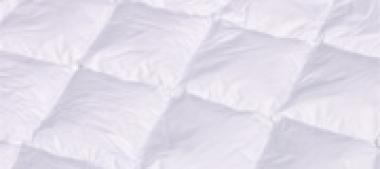Duvets sewn in diamond patterns or square boxes etc. – what are the differences ?
The type of duvet is crucially determined by the kind of stitching. A duvet is stitched-through in a certain manner to make the filling stay in place and permanently fix it.
Also, the way of stitching has an impact on the degree of thermal insulation. For instance, summer duvets are sewn fabric-to-fabric, intended to create cold zones. Winter duvets containing larger amounts of down and feathers are provided with interior baffle walls stitched between the upper and the lower sides of the fabric layers to impede the formation of such cold zones.
Both types of duvets are available in a number of different make-ups and appearances.
Only the traditional “bag duvet” is not stitched at all.
Only the traditional “bag duvet” is not stitched at all.
- Bag duvet: The so-called bag duvet consists just of the filling and the fabric shell without any special construction. It is not stitched-through at all and does not have any compartments. So the filling is not evenly spread over the area of the duvet. The traditional bag duvet is still available in the market though it has become less important in comparison with stitched-through duvets.
Initially, a small continental bag duvet was called “plumeau“ (size about 130 x 130 cm). Sometimes the term is also used for the traditional larger bag duvets without any compartments or stitched-through patterns.
- Duvet with diamond pattern: Small discontinuous baffle walls stitched alternately in crosswise and lengthwise ensure that the filling is fixed.
The capability of the down / feather filling to move inside the ticking shell is restrained. It is impossible for the filling to get out of place. The filling within the duvet can be spread according to desire. Since the interior baffle walls do not form enclosed compartments, they must no be filled one by one.
- Stitched-through duvet sewn in diamond pattern: The shell of the duvet is sewn in numerous small diamond patterns ensuring that the filling is permanently fixed. In this case, the upper and the lower sides of the ticking are sewn on top of one another – i.e. without any baffle walls.
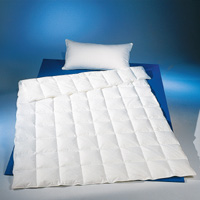 Example of a stitched-through duvet.
Example of a stitched-through duvet.
-
Duvet with interior baffle walls: This type of duvet is provided with continuous baffle walls which are stitched in diamond pattern between the upper and the lower sides of the ticking to make sure that the filling is evenly spread over the area of the duvet and the height is even at all places as requested. So-called cold zones cannot occur.Single compartments are constituted in various numbers. The duvet may for instance be composed of 3 x 4 or 4 x 6 boxes. The filling is divided in single compartments and permanently fixed that way. Each compartment is filled individually.The height of the interior baffle walls may range from to 2 cm to 15 cm in order to obtain the requested degree of thermal insulation (low baffle walls for a summer duvet and high ones for a winter duvet).
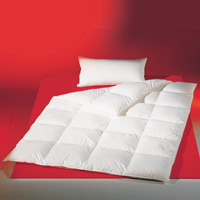
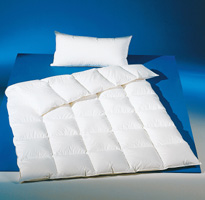

Examples of duvets with interior baffle walls.
- All-seasons duvet: This type of duvet consists of two single duvets with different filling weights: The lighter one is suitable for use in summer and the other duvet offers a higher degree of thermal insulation suitable for spring or autumn. If the two single duvets fit together (for instance with buttons, zip fasteners or tape), a duvet will be created which offers excellent thermal insulation, that is to say a winter duvet.
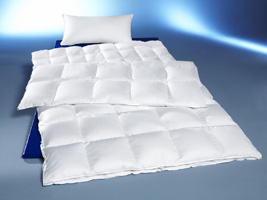 Example of a all-seasons duvet.
Example of a all-seasons duvet.











